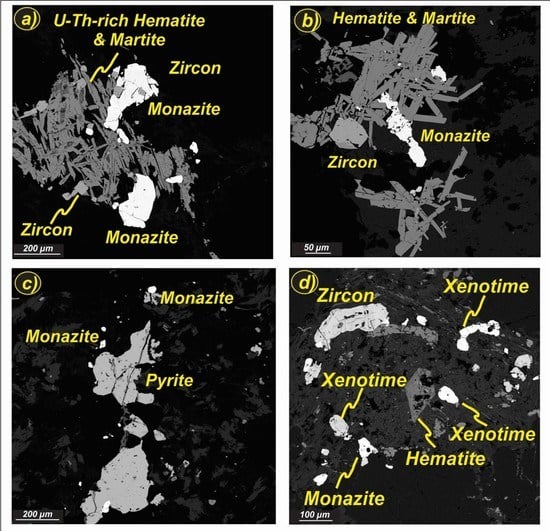U–Pb Geochronology of Hydrothermal Monazite from Uraniferous Greisen Veins Associated with the High Heat Production Mount Douglas Granite, New Brunswick, Canada
Abstract
1. Introduction
2. Geological Setting
3. Analytical Procedures
4. Greisen Veins: Petrographical Observations and Mineralogy
5. Results
5.1. U–Pb Monazite Geochronology of the Greisen Veins
5.2. High Heat Production Nature of the Mount Douglas Granite
6. Discussion
6.1. Mineralization Ages of Greisen Veins
6.2. Time Gap Between Mineralization and Intrusion: Implication for High Heat Production Granite in Metallogenesis
6.3. Mount Douglas Granite: High Potential for Geothermal Energy Resources
7. Conclusions
Supplementary Materials
Author Contributions
Funding
Acknowledgments
Conflicts of Interest
References
- Chandra, J.J. New Brunswick Radioactive Heat Product; Open File 80-92; New Brunswick Department of Natural Resources, Mineral Resources Branch: Fredericton, NB, Canada, 1980. [Google Scholar]
- Hassan, H.H. Uranium and Thorium Distribution in the Rocks of Southwestern New Brunswick, Canada. Ph.D. Thesis, University of New Brunswick, Fredericton, NB, Canada, 1984. [Google Scholar]
- Hassan, H.H.; Hale, W.E. Uranium and Thorium Distribution in the Rocks of Southwestern New Brunswick, Canada; Open File Report 86-10; New Brunswick Department of Natural Resources and Energy, Minerals and Energy Division: Fredericton, NB, Canada, 1987; 100p. [Google Scholar]
- Hassan, H.H.; Hale, W.E.; Chrzanowski, M. Geology of Uranium and Associated Elements in New Brunswick; Geological Survey of Canada, Open File 1769; Natural Resources and Energy: Fredericton, NB, Canada, 1987; ISBN 0662438116. [Google Scholar]
- McLeod, M.J.; Smith, E.A. Uranium; Profile No. 6; New Brunswick Department of Natural Resources; Lands, Minerals and Petroleum Division, Mineral Commodity: Fredericton, NB, Canada, 2010. [Google Scholar]
- Shinkle, D.; Lentz, D.R. Long Lake uranium deposit, north-central New Brunswick: A granite-hosted uraniferous polymetallic vein system in the Canadian Appalachians. In Proceedings of the AGS Abstracts—2007 Annual General Meeting, Moncton, NB, USA, 2–3 February 2007; pp. 28–29. [Google Scholar]
- Shinkle, D.; Lentz, D.R.; McCutcheon, S. The Early to Late Devonian North Pole Stream granitic suite: A strongly peraluminous granitic complex hosting a intragranitic vein-type uranium deposit, New Brunswick. In Proceedings of the Atlantic Geoscience Society 37th Colloquium and Annual General Meeting; Atlantic Geology, Fredericton, NB, Canada, 12–13 February 2011. [Google Scholar]
- McFarlane, C.R.M.; Harrison, M.T. Pb-diffusion in monazite: Constraints from a high-T contact aureole setting. Earth Planet. Sci. Lett. 2006, 250, 376–384. [Google Scholar] [CrossRef]
- Gardés, E.; Jaoul, O.; Montel, J.-M.; Seydoux-Guillaume, A.-M.; Wirth, R. Pb diffusion in monazite: An experimental study of Pb2+ + Th4+⇔2Nd3+ interdiffusion. Geochim. Cosmochim. Acta 2006, 70, 2325–2336. [Google Scholar] [CrossRef]
- Gardés, E.; Montel, J.-M.; Seydoux-Guillaume, A.-M.; Wirth, R. Pb diffusion in monazite: New constraints from the experimental study of Pb2+⇔Ca2+ interdiffusion. Geochim. Cosmochim. Acta 2007, 71, 4036–4043. [Google Scholar] [CrossRef]
- Vielreicher, M.N. Hydrothermal monazite and xenotime geochronology: A new direction for precise dating of orogenic gold mineralization. Soc. Econ. Geol. Newsl. 2003, 53, 9–16. [Google Scholar]
- Schandl, E.S.; Gorton, M.P. A textural and geochemical guide to the identification of hydrothermal monazite: Criteria for selection of samples for dating epigenetic hydrothermal ore deposits. Econ. Geol. 2004, 99, 1027–1035. [Google Scholar] [CrossRef]
- Grand’Homme, A.; Janots, E.; Bosse, V.; Seydoux-Guillaume, A.M.; De Ascenção Guedes, R. Interpretation of U-Th-Pb in-situ ages of hydrothermal monazite-(Ce) and xenotime-(Y): Evidence from a large-scale regional study in clefts from the western Alps. Miner. Pet. 2016, 110, 787–807. [Google Scholar] [CrossRef]
- Charnley, B.; Lentz, D.R.; McFarlane, C.R.M. Hydrothermal monazite and xenotime related to granites associated with the North Zone Mount Pleasant Sn-Zn-Cu-In (& W) deposits, NB, Canada: Preliminary studies. In Proceedings of the 14th Biennial Society for Geology Applied to Mineral Deposits (SGA) Meeting, Mineral Resources to Discover, Québec City, QC, Canada, 20–23 August 2017; pp. 369–372. [Google Scholar]
- Mohammadi, N. Petrogenesis of Tin-Tungsten-Molybdenum Mineralized Intragranitic Systems within the Highly Evolved Mount Douglas Polyphase Intrusive Complex, Southwestern New Brunswick, Canada. Ph.D. Thesis, University of New Brunswick, Fredericton, NB, Canada, 2018. [Google Scholar]
- McCutcheon, S.R.; Robinson, P.T. Geological Constraints on the Genesis of the Maritimes Basin, Atlantic Canada. In Sedimentary Basin and Basin-Forming Mechanisms; Beaumont, C., Tankard, A.J., Eds.; Canada Society of Petroleum Geologists: Calgary, AB, USA, 1987; Memoir 12; pp. 287–297. [Google Scholar]
- McLeod, M.J. Geology, Geochemistry and Related Mineral Deposits of the Saint George Batholith; Charlotte, Queens and Kings Counties, New Brunswick; Mineral Resources Report 5; New Brunswick, Natural Resources and Energy: Fredericton, NB, USA, 1990; 169p. [Google Scholar]
- Van Staal, C.R.; Whalen, J.B.; Valverde-Vaquero, P.; Zagorevski, A.; Rogers, N. Pre-Carboniferous, episodic accretion-related, orogenesis along the Laurentian margin of the northern Appalachians. Geol. Soc. Lond. Spec. Publ. 2009, 327, 271–316. [Google Scholar] [CrossRef]
- Whalen, J.B. Geology, Petrography, and Geochemistry of Appalachian Granites in New Brunswick and Gaspésie, Québec. Geol. Surv. Can. Bull. 1993, 436, 130. [Google Scholar]
- Whalen, J.B.; Fyffe, L.R.; Longstaffe, F.J.; Jenner, G.A. The position and nature of the Gander–Avalon boundary, southern New Brunswick, based on geochemical and isotopic data from granitoid rocks. Can. J. Earth Sci. 1996, 33, 129–139. [Google Scholar] [CrossRef]
- Yang, X.-M.; Lentz, D.R.; McCutcheon, S.R. Petrochemical evolution of subvolcanic granitoid intrusions within the Late Devonian Mount Pleasant Caldera, southwestern New Brunswick, Canada: Comparison of Au versus Sn-W-Mo-polymetallic mineralization systems. Atl. Geol. 2003, 39, 97–121. [Google Scholar] [CrossRef]
- Thorne, K.G.; Fyffe, L.R.; Creaser, R.A. Re-Os geochronological constraints on the mineralizing events within the Mount Pleasant Caldera: Implications for the timing of sub-volcanic magmatism. Atl. Geol. 2013, 49, 131–150. [Google Scholar] [CrossRef]
- Van Staal, C.R.; Barr, S.M. Lithospheric architecture and tectonic evolution of the Canadian Appalachians and associated Atlantic margin. Chapter 2. In Proceedings of the Tectonic Style in Canada: The Lithoprobe Perspective, St. John’s, NL, Canada, 31 October 2012; Percival, J.A., Cook, F.A., Clowes, R.M., Eds.; Special Paper 49. Geological Association of Canada: St. John’s, NL, Canada, 2012; pp. 41–95. [Google Scholar]
- Pearce, J.A.; Harris, N.B.W.; Tindle, A.G. Trace element discrimination diagrams for the tectonic interpretation of granitic rocks. J. Pet. 1984, 25, 956–983. [Google Scholar] [CrossRef]
- Christiansen, E.H.; Keith, J.D. Trace element systematics in silicic magmas: A metallogeneic prospective. In Proceedings of the Trace Element Geochemistry of Volcanic Rocks: Applications for Massive Sulfide Exploration, Winnipeg, MB, Canada, 24–26 May 2016; Wyman, D.A., Ed.; Short Course Notes. Geological Association of Canada: St. John’s, NL, Canada, 1996; Volume 12, pp. 115–151. [Google Scholar]
- Lentz, D.R.; Mohammadi, N. Petrogenesis and evolution of peraluminous Mount Douglas leucogranites, southwestern New Brunswick, Canada: Extreme fractionation linked to Sn-W-Mo-polymetallic mineralization. Acta Geol. Sin. Engl. Ed. 2014, 88, 1518–1520. [Google Scholar] [CrossRef]
- McLeod, M.J.; Taylor, R.P.; Lux, D.R. Geology, 40Ar/39Ar geochronology and Sn-W-Mo-bearing sheeted veins of the Mount Douglas Granite, southwestern New Brunswick. Can. Inst. Min. Met. Bull. 1988, 81, 70–77. [Google Scholar]
- Bevier, M.L. U-Pb geochronologic studies of igneous rocks in N.B. In Proceedings of the Thirteenth Annual Review of Activities, Project Resumes, Fredericton, NB, Canada, January 1988; Abbott, S., Ed.; Information Circular 88. New Brunswick Department of Natural Resources and Energy, Minerals and Energy Division: Fredericton, NB, Canada, 1988; pp. 134–140. [Google Scholar]
- Mohammadi, N.; Fyffe, L.; McFarlane, C.R.M.; Thorne, K.G.; Lentz, D.R.; Charnley, B.; Branscombe, L.; Butler, S. Geological relationships and laser ablation ICP-MS U-Pb geochronology of the Saint George Batholith, southwestern New Brunswick, Canada: Implications for its tectonomagmatic evolution. Atl. Geol. 2017, 53, 207–240. [Google Scholar] [CrossRef]
- Clarke, D.B.; McFarlane, C.R.M.; Hamilton, D.; Stevens, D. Forensic igneous petrology: Locating the source quarry for the “Black Granite” Titanic Headstones in Halifax, Nova Scotia, Canada. Can. Miner. 2017, 55, 145–177. [Google Scholar] [CrossRef]
- NR-7 Metallogenic Map of New Brunswick; New Brunswick Department of Natural Resources and Energy: Fredericton, NB, USA, 2002.
- McFarlane, C.R.M.; Luo, Y. U-Pb geochronology using 193 nm excimer LA-ICP-MS optimized for in-situ accessory mineral dating in thin sections. Geosci. Can. 2012, 39, 158–172. [Google Scholar]
- McFarlane, C.R.M. Allanite U-Pb geochronology by 193 nm LA ICP-MS using NIST610 glass for external calibration. Chem. Geol. 2016, 438, 91–102. [Google Scholar] [CrossRef]
- McFarlane, C.R.M. A geochronological framework for sedimentation and Mesoproterozoic tectono-magmatic activity in lower Belt–Purcell rocks exposed west of Kimberley, British Columbia. Can. J. Earth Sci. 2015, 52, 444–465. [Google Scholar] [CrossRef]
- Azadbakht, Z.; McFarlane, C.E.M.; Lentz, D.R. Precise U-Pb ages for the cogenetic alkaline Mount LaTour and peraluminous Mount Elizabeth granites of the South Nepisiguit River Plutonic Suite, northern New Brunswick, Canada. Atl. Geol. 2016, 52, 189. [Google Scholar] [CrossRef]
- Williams, M.L.; Jercinovic, M.J.; Goncalves, P.; Mahan, K. Format and philosophy for collecting, compiling, and reporting microprobe monazite ages. Chem. Geol. 2006, 225, 1–15. [Google Scholar] [CrossRef]
- Aleinikoff, J.N.; Schenck, W.S.; Plank, M.O.; Srogi, L.; Fanning, C.M.; Kamo, S.L.; Bosbyshell, H. Deciphering igneous and metamorphic events in high-grade rocks of the Wilmington Complex, Delaware: Morphology, cathodoluminescence and backscattered electron zoning, and SHRIMP U-Pb geochronology of zircon and monazite. Geol. Soc. Am. Bull. 2006, 118, 39–64. [Google Scholar] [CrossRef]
- Hetherington, C.J.; Backus, E.L.; McFarlane, C.R.M.; Fisher, C.M.; Pearson, D.G. Origins of textural, compositional, and isotopic complexity in monazite and its petrochronological analysis. In AGU Geophysical Monograph Series “Microstructural Geochronology: Planetary Records Down to Atom Scale; Moser, D., Fernando, C., Darling, J., Reddy, S., Kimberly, T., Eds.; American Geophysical Union (AGU): Washington, DC, USA, 2017; pp. 63–90. [Google Scholar]
- Ludwig, K.R. Isoplot 3.75: A Geochronological Toolkit for Microsoft Excel; Spec. Publ. 5; BGC Berkeley Geochronology Center: Berkeley, CA, USA, 2012; p. 75. [Google Scholar]
- Thorne, K.G.; Fyffe, L.R.; Seaman, A.A.; Parkhill, M.A.; Pronk, A.G.; McClenaghan, S.H. Granite-Related Mineralization at the Sisson W-Mo Deposit and the Zealand Station Be-Mo-W Prospect, New Brunswick; New Brunswick Department of Energy and Mines, Exploration, Mining and Petroleum Conference Field Trip: Fredericton, NB, USA, 2014. [Google Scholar]
- Strong, D.F. Ore deposit models-5. A model for granophile mineral deposits. Geosci. Can. 1981, 8, 155–161. [Google Scholar]
- Mohammadi, N.; McFarlane, C.R.M.; Lentz, D.R.; Thorne, K.G. Ta-rich wolframite from the Sn-W-Mo-bearing Mount Douglas leucogranite, southwestern New Brunswick, Canada: A SEM and laser ablation ICP-MS study. In Proceedings of the GAC-MAC Annual Meeting, Whitehorse, YT, Canada, 1–3 June 2016. [Google Scholar]
- Mohammadi, N.; Lentz, D.R.; McFarlane, C.R.M. Geochemistry of Cd-rich Sphalerite of Greisen Veins from the Sn-W-Mo-Bearing Mt. Douglas Leucogranite, NB, Canada. In Proceedings of the Exploration, Mining and Petroleum New Brunswick Conference (EMP), Fredericton, NB, Canada, 6–8 November 2016. [Google Scholar]
- Mohammadi, N.; Mcfarlane, C.R.M.; Lentz, D.R. Raman spectroscopy and laser ablation ICP MS of hematite and martite from uraniferous greisen veins, Mt. Douglas Granite, NB, Canada. In Proceedings of the 26th Anniversary Goldschmidt, Yokohama, Japan, 26 June–1 July 2016. [Google Scholar]
- Marshall, T.A.; Morris, K.; Law, G.T.W.; Livens, F.R.; Mosselmans, J.F.W.; Bots, P.; Shaw, S. Incorporation of uranium into hematite during crystallization from ferrihydrite. Environ. Sci. Technol. 2014, 48, 3724–3731. [Google Scholar] [CrossRef] [PubMed]
- Andersen, T. Correction of common lead in U–Pb analyses that do not report 204Pb. Chem. Geol. 2002, 192, 59–79. [Google Scholar] [CrossRef]
- Sun, Z.; Wang, A.; Liu, J.; Hu, B.; Chen, G. Radiogenic heat production of granites and potential for hot dry rock geothermal resource in Guangdong Province, Southern China. World Geotherm. Congr. 2015, 2015, 2–6. [Google Scholar]
- Rybach, L.; Bodmer, P.; Pavoni, N.; Mueller, S. Siting criteria for heat extraction from hot dry rock; Application to Switzerland. Pure Appl. Geophys. Pageoph 1978, 116, 1211–1224. [Google Scholar] [CrossRef]
- Wang, A.D.; Sun, Z.X.; Hu, B.Q.; Liu, J.H.; Liu, C.D. Guangdong, a potential province for developing hot dry rock geothermal resource. Appl. Mech. Mater. 2014, 492, 583–585. [Google Scholar] [CrossRef]
- Rybach, L. Determination of heat production rate. In Proceedings of the Handbook of Terrestrial Heat Flow Density Determination; Hänel, R., Rybach, L.L., Stegena, Eds.; Kluwer: Dordrecht, The Netherlands, 1988; pp. 125–142. [Google Scholar]
- Thomas, M.D.; Willis, C. Gravity modelling of the Saint George Batholith and adjacent terrane within the Appalachian Orogen, southern New Brunswick. Can. J. Earth Sci. 1989, 26, 561–576. [Google Scholar] [CrossRef]
- Leat, P.T.; Jordan, T.A.; Flowerdew, M.J.; Riley, T.R.; Ferraccioli, F.; Whitehouse, M.J. Jurassic high heat production granites associated with the Weddell Sea rift system, Antarctica. Tectonophysics 2018, 722, 249–264. [Google Scholar] [CrossRef]
- Rudnick, R.L.; Gao, S. Composition of the continental crust. Treatise Geochem. 2003, 3, 1–64. [Google Scholar]
- Shrivastava, K.L.; Ram, D.; Gaur, V. High heat producing radioactive granites of Malani igneous suite at northeast of Jodhpur, northwestern India. J. Geol. Soc. India 2017, 89, 291–294. [Google Scholar] [CrossRef]
- Taylor, S.R.; McLennan, S.M. The Continental Crust: Its Composition and Evolution; Blackwell: Oxford, UK, 1985. [Google Scholar]
- Taylor, S.R. Trace element abundances and the chondritic Earth model. Geochim. Cosmochim. Acta 1964, 28, 1989–1998. [Google Scholar] [CrossRef]
- Sharma, R.S. High heat production granites of Jhunjhunu area, Rajasthan, India. Bull. Indian Geolo. Assoc 1994, 27, 55–61. [Google Scholar]
- Srivastava, P.K. High heat producing granites of Degana, Rajasthan. Indian J. Geochem. 2003, 18, 149–155. [Google Scholar]
- Kochhar, N. The Malani supercontinent: Siberia, Mongolia, Kazakhstan connection during Late-Proterozoic. In Proceedings of the 34th International Geological Congress, Brisbane, Australia, 5–10 August 2012. [Google Scholar]
- Morgan, P.; Sass, J.H. Thermal regime of the continental lithosphere. J. Geodyn. 1984, 1, 143–166. [Google Scholar] [CrossRef]
- Morgan, P. Crustal radiogenic heat production and the selective survival of ancient continental crust. J. Geophys. Res. 1985, 90, C561. [Google Scholar] [CrossRef]
- Simpson, P.R.; Plant, J.A. Role of high heat production granites in uranium province formation. In Uranium Geochemistry, Mineralogy, Geology, Exploration and Resources; Springer: Dordrecht, The Netherlands, 1984; pp. 167–178. [Google Scholar]
- Vigneresse, J.L.; Jolivet, J.; Cuney, M.; Bienfait, G. Heat flow, heat production and granite depth in western France. Geophys. Res. Lett. 1987, 14, 275–278. [Google Scholar] [CrossRef]
- Webb, P.C.; Lee, M.K.; Brown, G.C. Heat flow–heat production relationships in the UK and the vertical distribution of heat production in granite batholiths. Geophys. Res. Lett. 1987, 14, 279–282. [Google Scholar] [CrossRef]
- Jolivet, J.; Bienfait, G.; Vigneresse, J.L.; Cuney, M. Heat flow and heat production in Brittany (Western France). Tectonophysics 1989, 159, 61–72. [Google Scholar] [CrossRef]
- Louden, K.E.; Mareschal, J.-C. Measurements of radiogenic heat production on basement samples from sites 897 and 900. In Proceedings of the Ocean Drilling Program, Scientific Results; Whitmarsh, R.B., Sawyer, D.S., Klaus, A., Masson, D.G., Eds.; Ocean Drilling Program: College Station, TX, USA, 1996; pp. 675–682. [Google Scholar]
- Kromkhun, K. Petrogenesis of High Heat Producing Granite: Implication for Mt Painter Province, South Australia. Ph.D. Thesis, University of Adelaide, Adelaide, Australia, 2010. [Google Scholar]
- Marshall, V.; Van Zyl, J.; Bryan, S.; Uysal, T.; Gasparon, M. Comparative petrology and geochemistry of high heat-producing granites in Australia and Europe. In Proceedings of the 2010 Australian Geothermal Energy Conference, Adelaide, Australia, 16–19 November 2010; pp. 41–47. [Google Scholar]
- Singh, H.K.; Kumar, Y.; Chandrasekharam, D.; Gurav, T.; Singh, B. High-heat-producing granites of East Dharwar Craton around Gugi, Karnataka, and their possible influence on the evolution of Rajapur thermal springs, Deccan Volcanic Province, India. Geotherm. Energy 2014, 2, 2. [Google Scholar] [CrossRef]
- Beamish, D.; Busby, J. The Cornubian geothermal province: Heat production and flow in SW England: Estimates from boreholes and airborne gamma-ray measurements. Geotherm. Energy 2016, 4, 4. [Google Scholar] [CrossRef]
- England, P.C.; Oxburgh, E.R.; Richardson, S.W. Heat refraction and heat production in and around granite plutons in north-east England. Geophys. J. Int. 1980, 62, 439–455. [Google Scholar] [CrossRef]
- Clark, A.H.; Farrar, E.; Kontak, D.J.; Langridge, R.J.; Arenas, F.M.J.; France, L.J.; McBride, S.L.; Woodman, P.L.; Wasteneys, H.A.; Sandeman, H.A.; et al. Geological and geochronological constructions on the metallogenic evolution of the Andes of southeastern Peru. Econ. Geol. 1990, 85, 1520–1583. [Google Scholar] [CrossRef]
- Rogers, J.J.W.; Adams, J.A.S. Thorium. In Proceedings of the Handbook of Geochemistry; Wedepohl, K.H., Ed.; Springer: Berlin, Germany, 1969; pp. 11–14. [Google Scholar]
- Kimberley, S.J. Uranium deposits, their mineralogy and origin: A short course. Miner. Assoc. Can. Short Course Handb. 1978, 3, 521. [Google Scholar]
- Fehn, U.; Cathles, L.M.; Holland, H.D. Hydrothermal convection and uranium deposits in abnormally radioactive pluton. Econ. Geol. 1978, 73, 1556–1566. [Google Scholar] [CrossRef]
- Drury, M.J.; Jessop, A.M.; Lewis, T.J. The thermal nature of the Canadian Appalachian crust. Tectonophysics 1987, 133, 1–14. [Google Scholar] [CrossRef]
- Allman-Ward, P. Distribution of uranium and thorium in the western lobe of the St. Austell granite and the effects of alteration processes. In Proceedings of the High Heat Production (HHP) Granites, Hydrothermal Circulation and Ore Genesis. Conference, Institution of Mining and Metallurgy, St. Austell, UK, 22–25 September 1985; pp. 437–458. [Google Scholar]
- Robb, L. Introduction to Ore-Forming Processes; John Wiley and Sons Ltd.: Oxford, UK, 2005; ISBN 0632063785. [Google Scholar]
- Cathles, L.M. Fluid flow and genesis of hydrothermal ore deposits. Econ. Geol. 1981, 75, 424–457. [Google Scholar]
- Fowler, C.M.R.; Nisbet, E.G. The thermal background to metamorphism—II: Simple two-dimensional conductive models. Geosci. Can. 1982, 9, 208–214. [Google Scholar]
- Nisbet, E.G.; Fowler, C.M.R. The thermal background to metamorphism -1. Simple one-dimensional conductive models. Geosci. Can. 1982, 9, 161–164. [Google Scholar]
- Richardson, S.W.; Oxburgh, E.R. Heat flow, radiogenic heat production and crustal temperatures in England and Wales. J. Geol. Soc. Lond. 1978, 135, 323–337. [Google Scholar] [CrossRef]
- Lee, M.K.; Brown, G.C.; Webb, P.C.; Wheildon, J.; Rollin, K.E. Heat flow, heat production and thermo-tectonic setting in mainland UK. J. Geol. Soc. Lond. 1987, 144, 35–42. [Google Scholar] [CrossRef]
- Förster, A.; Förster, H.-J. Crustal composition and mantle heat flow: Implications from surface heat flow and radiogenic heat production in the Variscan Erzgebirge (Germany). J. Geophys. Res. Solid Earth 2000, 105, 27917–27938. [Google Scholar] [CrossRef]
- Bea, F. The sources of energy for crustal melting and the geochemistry of heat-producing elements. Lithos 2012, 153, 278–291. [Google Scholar] [CrossRef]
- Hu, S.; He, L.; Wang, J. Heat flow in the continental area of China: A new data set. Earth Planet. Sci. Lett. 2000, 179, 407–419. [Google Scholar] [CrossRef]
- Wang, J.; Hu, S.; Pang, Z.; He, L.; Zhao, P.; Zhu, C.; Rao, S.; Tang, X.; Kong, Y.; Luo, L.; et al. Estimate of geothermal resources potential for hot dry rock in the continental area of China. Sci. Technol. Rev. 2012, 30, 25–31. [Google Scholar]
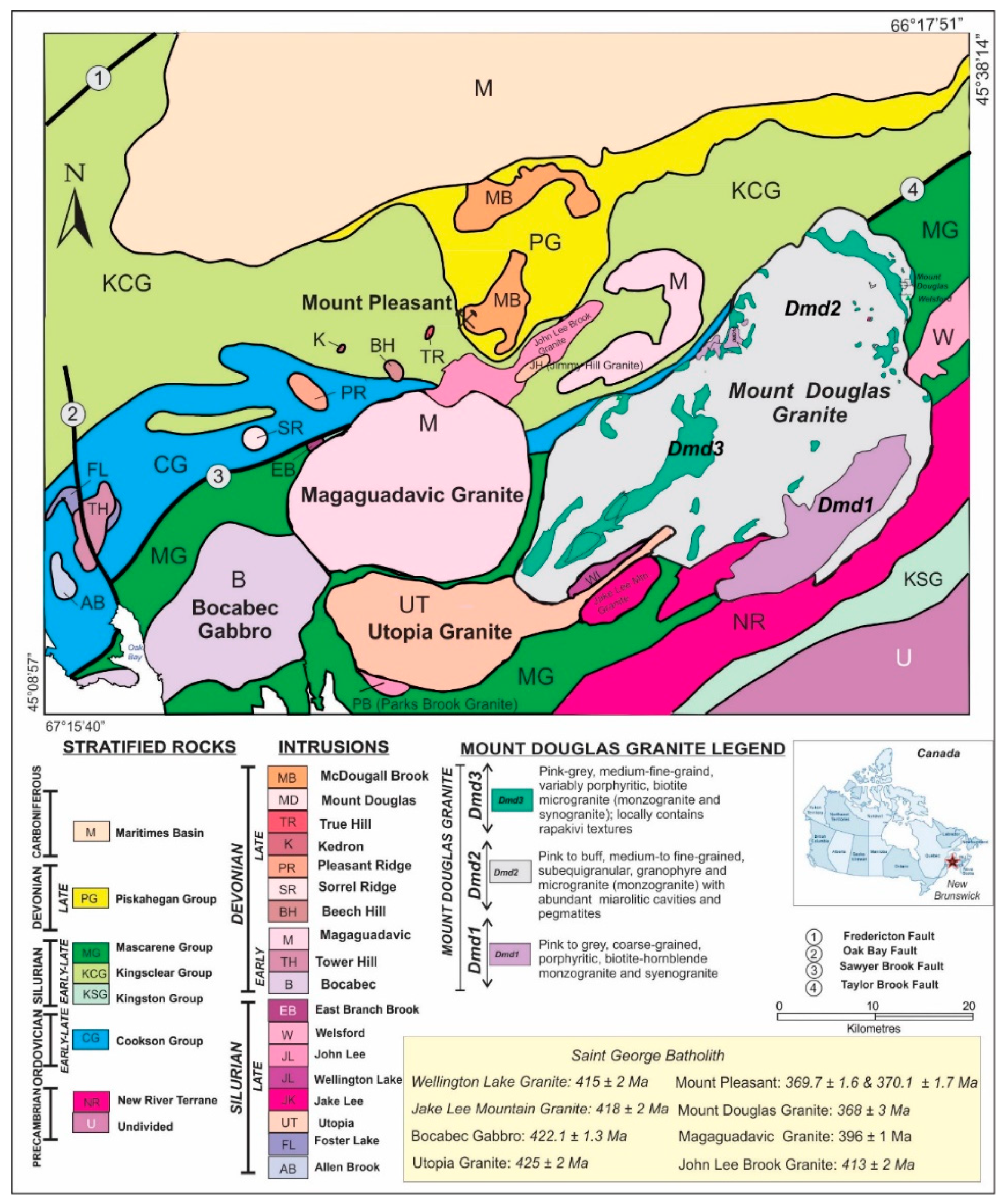
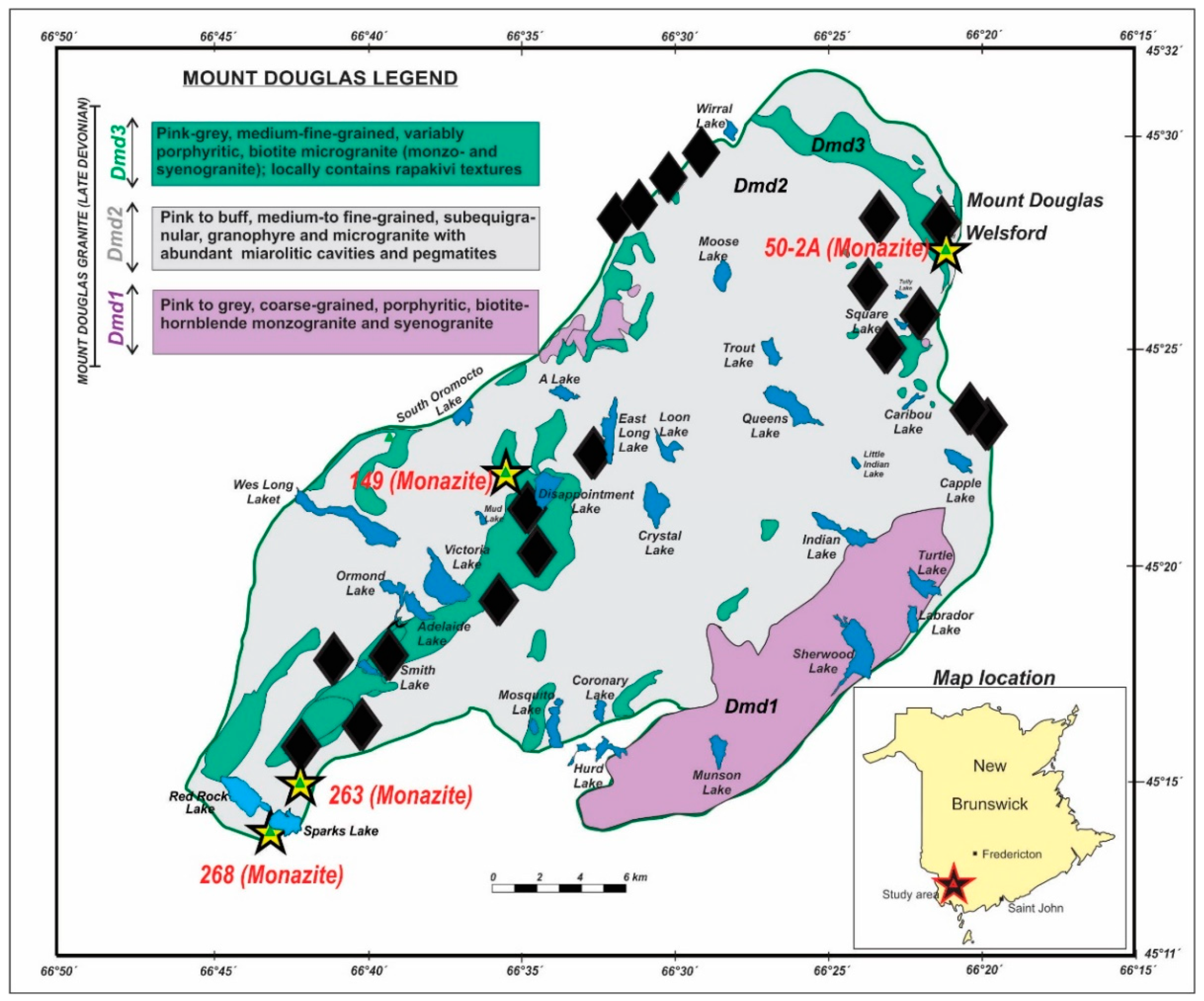
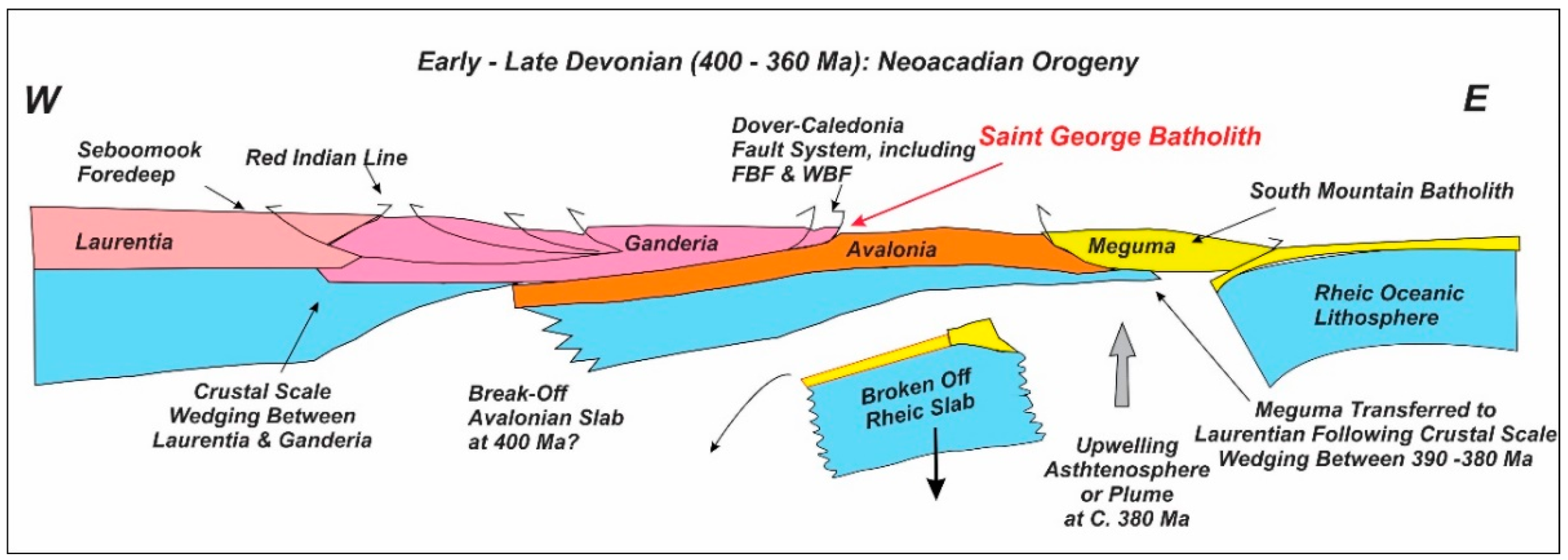

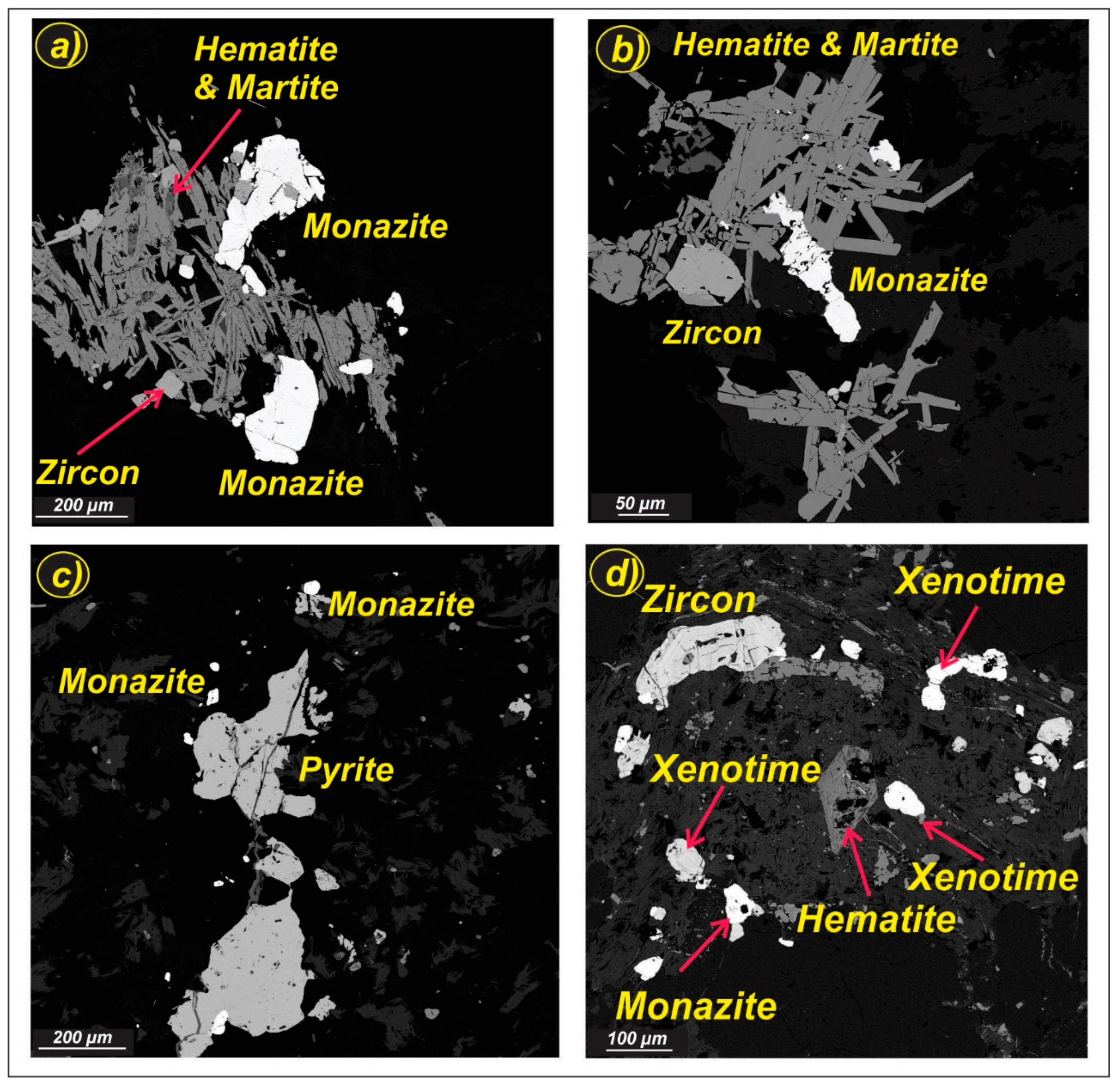

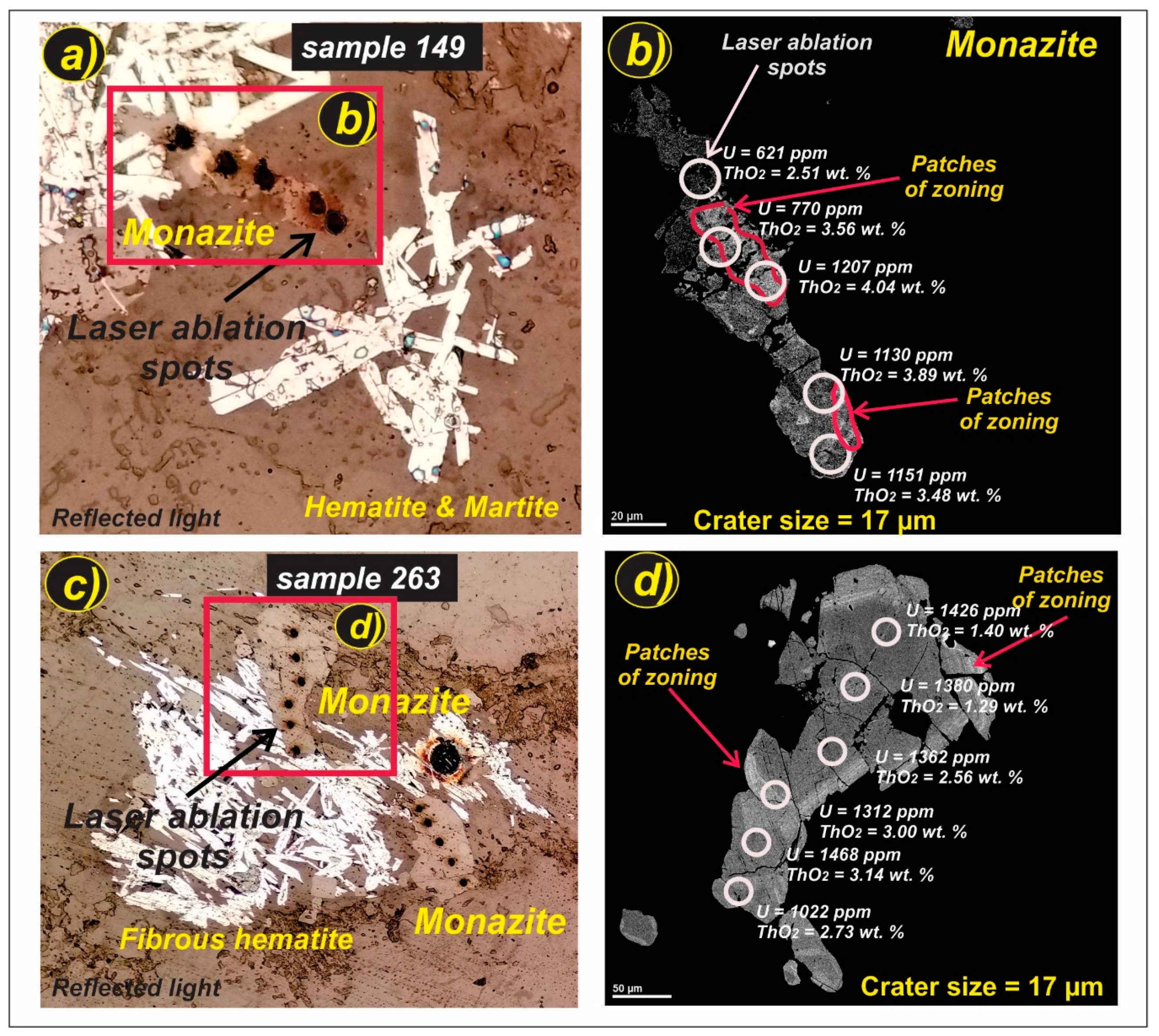
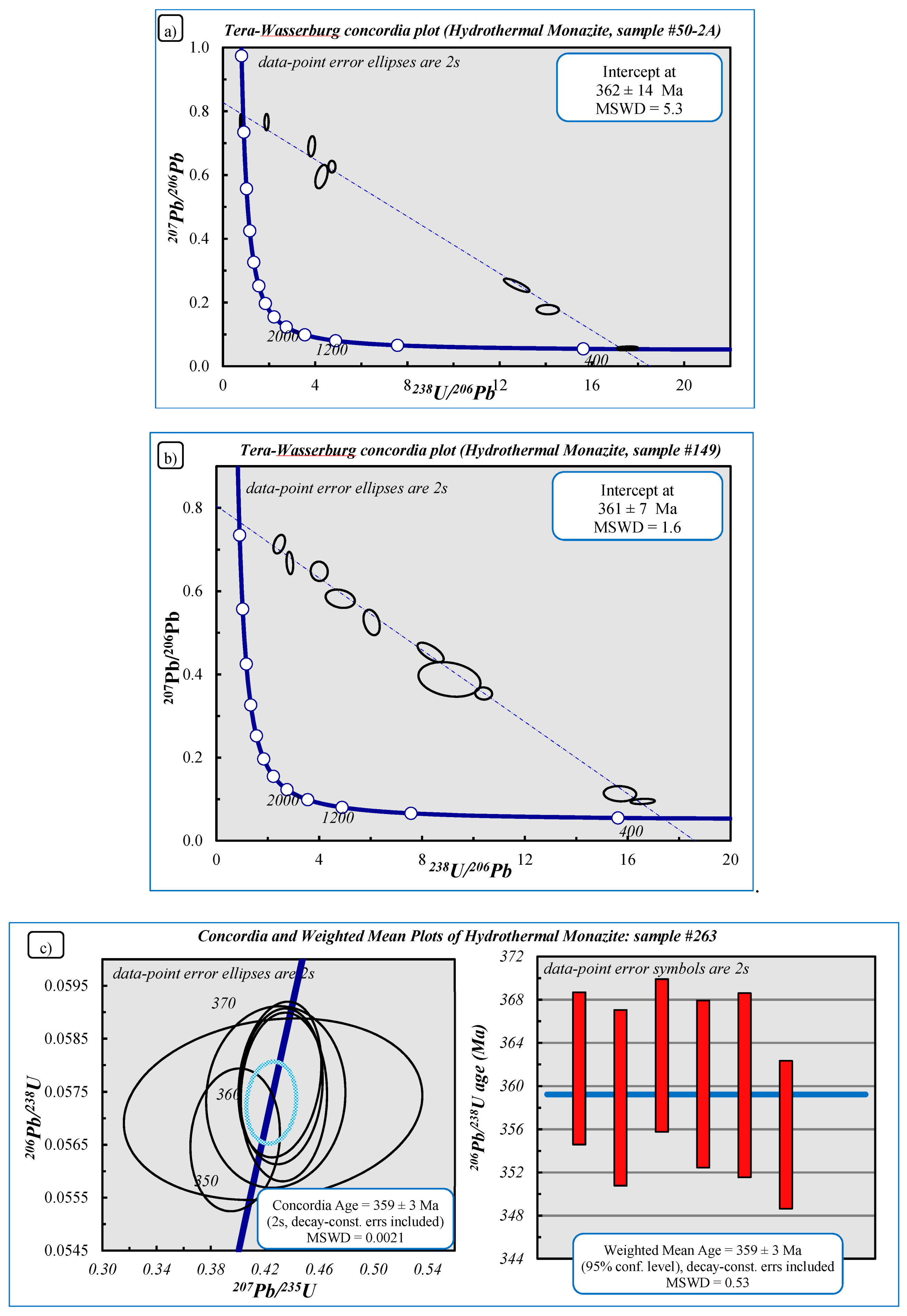
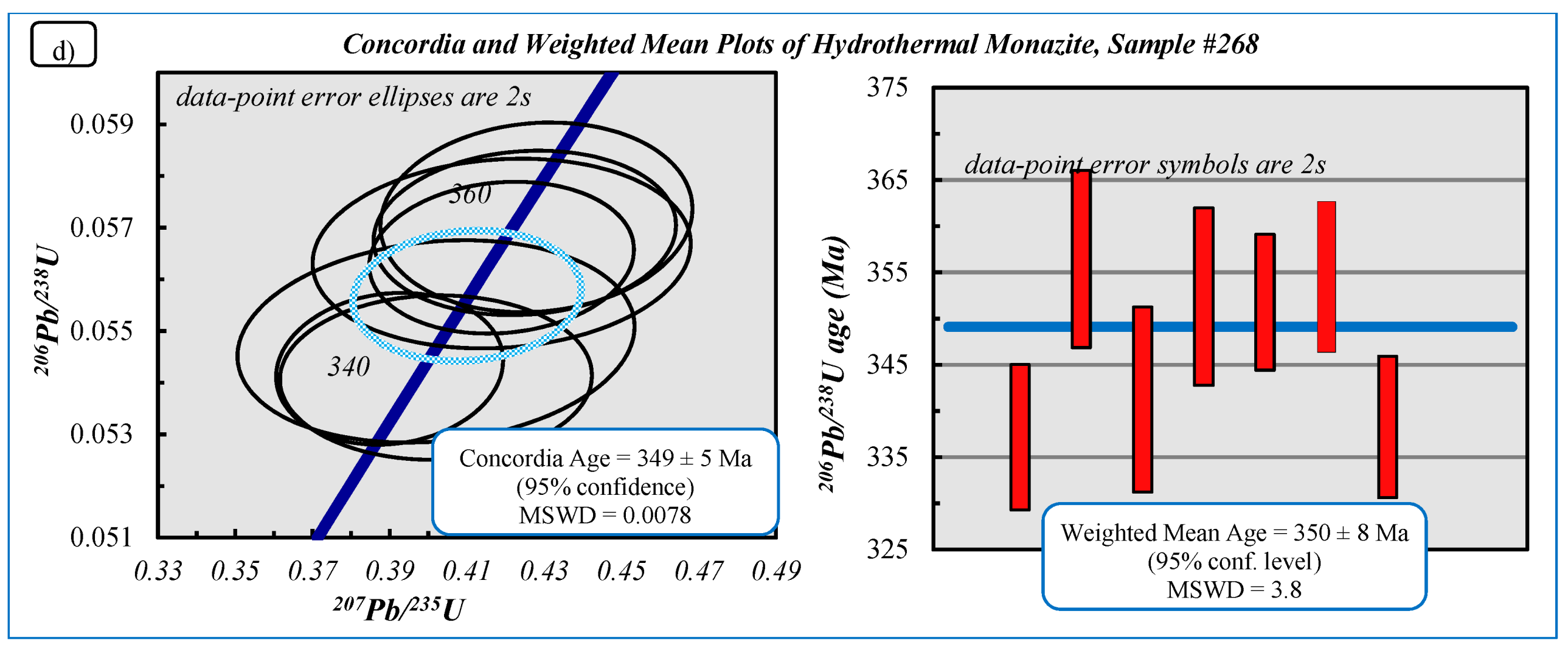

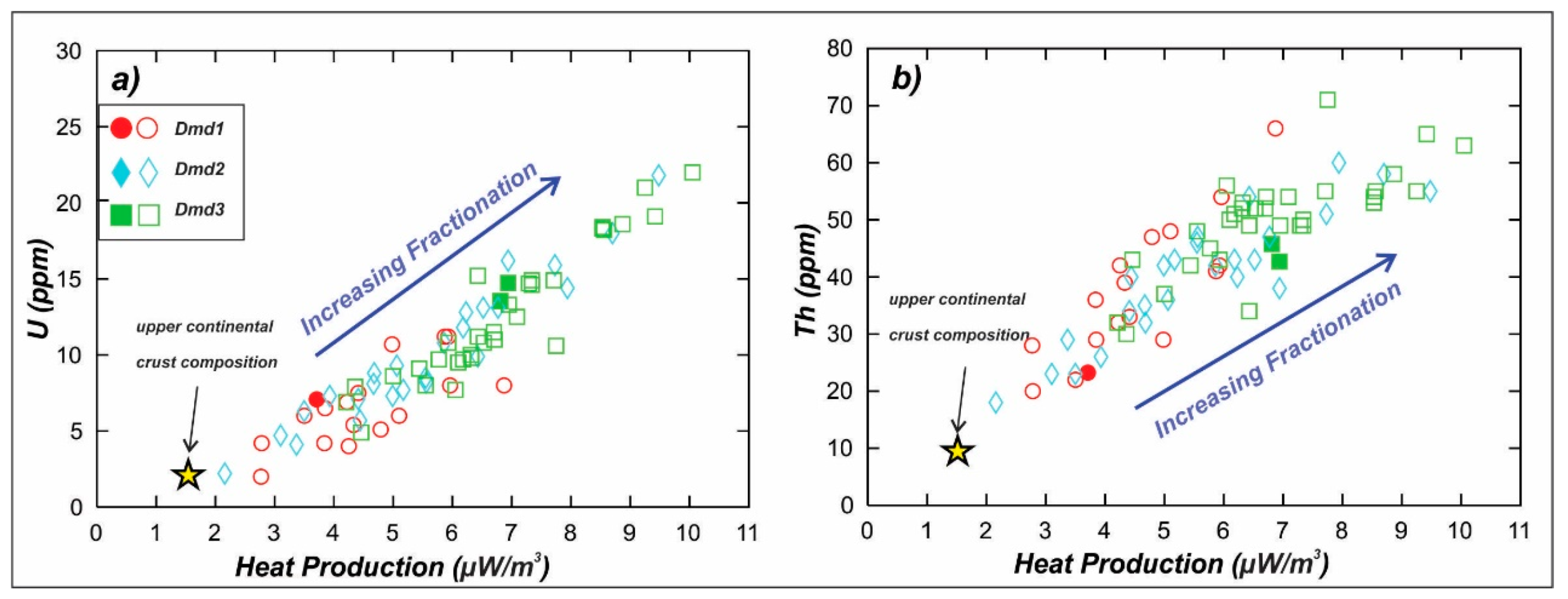
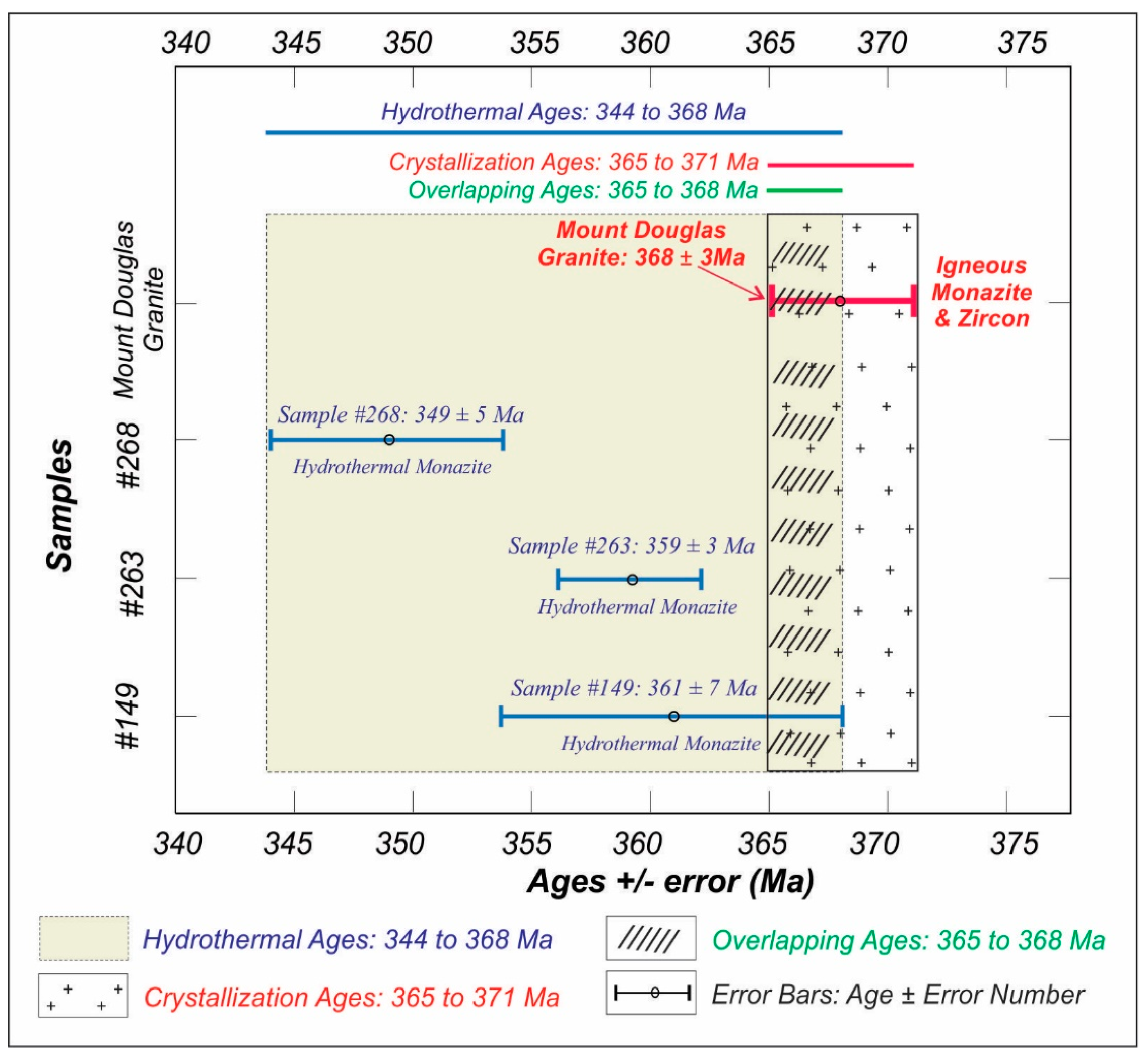
| Unit | U (ppm) Range | U (ppm) Mean | U (ppm) Median | Th (ppm) Range | Th (ppm) Mean | Th (ppm) Median | n* |
|---|---|---|---|---|---|---|---|
| Dmd1 | 2-11 | 7 | 6.8 | 19–66 | 37 | 40 | 15 |
| Dmd2 | 2-22 | 10 | 8.8 | 18–60 | 40 | 42 | 24 |
| Dmd3 | 5-22 | 13 | 11.1 | 30–71 | 51 | 52 | 31 |
| Sample | Material | Type | ThO2 (wt.%) Range | ThO2 (wt.%) Weighted Mean | ThO2 (wt.%) Median | U (ppm) Range | U (ppm) Weighted Mean | U (ppm) Median | U/Th | Age (Ma) | Error | Age (Ma) Range | MSWD | Conc./Inverse | Spot | n |
|---|---|---|---|---|---|---|---|---|---|---|---|---|---|---|---|---|
| 50-2A | Monazite * | igneous | 2.49–10.56 | 6.02 | 6.2 | 88–2911 | 1203 | 920 | 0.01–0.03 | 362 | 14 | 347–376 | 5.3 | inverse | 8 | 6 |
| 149# | Monazite | hydrothermal | 1.09–5.68 | 3.60 | 3.7 | 307–1207 | 899 | 1031 | 0.02–0.04 | 361 | 7 | 354–368 | 1.6 | inverse | 10 | 10 |
| 263# | Monazite | hydrothermal | 1.29–5.12 | 3.3 | 3.3 | 533–1824 | 1287 | 1371 | 0.02–0.12 | 359 | 3 | 356–362 | 0.0021 | concordia | 22 | 6 |
| 268# | Monazite | hydrothermal | 0.1–3.12 | 0.88 | 0.4 | 285–2535 | 1050 | 968 | 0.04–0.45 | 349 | 5 | 344–354 | 0.0075 | concordia | 11 | 7 |
| Spot | Approx. conc. | U/Th | 204Pb (Cps) | 206PbCps/ 204PbCps | %Pb* | Final Isotope Ratios (Used for Tera-Wasserburg Concordia Diagrams) | err. corr. | Ages (Ma) | %conc. | Final Isotope Ratios (Used for Conventional Concordia Diagram) | err. corr. | ||||||||||
|---|---|---|---|---|---|---|---|---|---|---|---|---|---|---|---|---|---|---|---|---|---|
| U (ppm) | Th (ppm) | 238U/ 206Pb | 2σ | 207Pb/ 206Pb | 2σ | 207Pb/ 235U | 2σ | 206Pb/ 238U | 2σ | 207Pb/ 235U | 2σ | 206Pb/ 238U | 2σ | ||||||||
| 50-2A-1 | 1977 | 61400 | 0.03 | 79 | 108 | 83.13 | 14.08 | 0.40 | 0.178 | 0.012 | −0.02 | 1011 | 50 | 442 | 12 | 43.7 | 1.725 | 0.160 | 0.071 | 0.002 | 0.479 |
| 50-2A-2 | 88 | 24300 | 0.00 | 58 | 20 | 53.60 | 4.27 | 0.22 | 0.595 | 0.030 | 0.44 | 3033 | 61 | 1347 | 64 | 44.4 | 18.900 | 1.200 | 0.234 | 0.012 | 0.686 |
| 50-2A-3 | 178 | 21850 | 0.01 | 137 | 21 | 49.10 | 3.85 | 0.12 | 0.690 | 0.026 | 0.23 | 3259 | 50 | 1493 | 43 | 45.8 | 23.800 | 1.200 | 0.260 | 0.008 | 0.608 |
| 50-2A-4 | 1330 | 55200 | 0.02 | 600 | 24 | 53.97 | 4.73 | 0.13 | 0.626 | 0.015 | −0.01 | 2973 | 37 | 1236 | 30 | 41.6 | 17.820 | 0.680 | 0.212 | 0.006 | 0.886 |
| 50-2A-5 | 191 | 35780 | 0.01 | 596 | 22 | 99.02 | 0.77 | 0.02 | 0.767 | 0.019 | 0.19 | 4986 | 40 | 5389 | 110 | 108.1 | 134.800 | 5.500 | 1.306 | 0.040 | 0.851 |
| 50-2A-6 | 509 | 53300 | 0.01 | 396 | 20 | 54.50 | 1.89 | 0.08 | 0.766 | 0.021 | 0.04 | 4062 | 52 | 2732 | 89 | 67.3 | 53.500 | 2.700 | 0.529 | 0.021 | 0.871 |
| 50-2A-7 | 2436 | 78800 | 0.03 | 181 | 68 | 73.90 | 12.74 | 0.45 | 0.254 | 0.017 | −0.82 | 1313 | 72 | 487 | 17 | 37.1 | 2.790 | 0.270 | 0.079 | 0.003 | 0.944 |
| 50-2A-8 | 2911 | 92800 | 0.03 | 3 | 3573 | 99.01 | 17.53 | 0.34 | 0.056 | 0.002 | 0.26 | 365 | 14 | 358 | 7 | 98.0 | 0.435 | 0.020 | 0.057 | 0.001 | 0.064 |
| 149-1 | 1151 | 30550 | 0.04 | 111 | 55 | 60.20 | 10.40 | 0.27 | 0.354 | 0.012 | −0.06 | 1796 | 36 | 592 | 14 | 33.0 | 4.820 | 0.200 | 0.096 | 0.003 | 0.560 |
| 149-2 | 1080 | 47300 | 0.02 | 206 | 41 | 55.40 | 8.33 | 0.42 | 0.453 | 0.019 | −0.67 | 2152 | 78 | 728 | 35 | 33.8 | 7.730 | 0.640 | 0.120 | 0.006 | 0.938 |
| 149-3 | 667 | 33400 | 0.02 | 121 | 31 | 58.70 | 9.07 | 0.99 | 0.388 | 0.034 | −0.22 | 1986 | 130 | 673 | 66 | 33.9 | 6.070 | 1.700 | 0.110 | 0.012 | 0.778 |
| 149-4 | 307 | 9580 | 0.03 | 98 | 28 | 52.60 | 6.04 | 0.26 | 0.525 | 0.025 | −0.32 | 2585 | 71 | 985 | 39 | 38.1 | 12.400 | 0.960 | 0.166 | 0.007 | 0.610 |
| 149-5 | 1207 | 35500 | 0.03 | 445 | 27 | 56.10 | 4.82 | 0.46 | 0.582 | 0.018 | −0.23 | 2916 | 85 | 1215 | 97 | 41.7 | 16.690 | 2.100 | 0.208 | 0.020 | 0.839 |
| 149-6 | 770 | 31270 | 0.02 | 526 | 24 | 52.90 | 4.00 | 0.27 | 0.648 | 0.019 | −0.04 | 3186 | 63 | 1436 | 80 | 45.1 | 22.190 | 2.400 | 0.250 | 0.017 | 0.869 |
| 149-7 | 1073 | 49900 | 0.02 | 582 | 22 | 55.50 | 2.86 | 0.11 | 0.668 | 0.022 | −0.21 | 3554 | 54 | 1930 | 60 | 54.3 | 32.100 | 1.700 | 0.350 | 0.013 | 0.840 |
| 149-8 | 988 | 22400 | 0.04 | 26 | 152 | 91.60 | 15.70 | 0.52 | 0.113 | 0.015 | −0.08 | 690 | 69 | 398 | 13 | 57.7 | 1.000 | 0.170 | 0.064 | 0.002 | 0.389 |
| 149-9 | 621 | 22090 | 0.03 | 729 | 23 | 53.60 | 2.44 | 0.19 | 0.713 | 0.018 | 0.37 | 3787 | 63 | 2209 | 130 | 58.3 | 40.600 | 3.400 | 0.409 | 0.031 | 0.547 |
| 149-10 | 1130 | 34220 | 0.03 | 26 | 177 | 93.88 | 16.58 | 0.39 | 0.095 | 0.005 | 0.19 | 582 | 25 | 377 | 9 | 64.8 | 0.783 | 0.044 | 0.060 | 0.001 | 0.158 |
| 263-1 | 1227 | 38820 | 0.03 | 152 | 45 | 58.90 | 13.06 | 0.26 | 0.367 | 0.011 | 0.42 | 1612 | 28 | 476 | 9 | 29.5 | 3.901 | 0.140 | 0.077 | 0.002 | 0.214 |
| 263-2 | 1022 | 23990 | 0.04 | 180 | 41 | 53.10 | 9.83 | 0.21 | 0.407 | 0.012 | 0.39 | 1944 | 32 | 624 | 13 | 32.1 | 5.800 | 0.210 | 0.102 | 0.002 | 0.395 |
| 263-3 | 1513 | 42000 | 0.04 | 146 | 55 | 66.50 | 12.79 | 0.44 | 0.307 | 0.017 | 0.16 | 1483 | 62 | 485 | 16 | 32.7 | 3.260 | 0.330 | 0.078 | 0.003 | 0.596 |
| 263-4 | 1285 | 22320 | 0.06 | 184 | 48 | 61.00 | 10.59 | 0.36 | 0.347 | 0.016 | 0.75 | 1757 | 61 | 581 | 19 | 33.1 | 4.640 | 0.350 | 0.094 | 0.003 | 0.892 |
| 263-5 | 1416 | 34000 | 0.04 | 93 | 89 | 73.00 | 13.18 | 0.30 | 0.255 | 0.012 | −0.34 | 1314 | 44 | 472 | 10 | 35.9 | 2.680 | 0.160 | 0.076 | 0.002 | 0.679 |
| 263-6 | 1287 | 34900 | 0.04 | 73 | 98 | 74.70 | 13.11 | 0.34 | 0.242 | 0.010 | −0.20 | 1288 | 43 | 474 | 12 | 36.8 | 2.560 | 0.150 | 0.076 | 0.002 | 0.625 |
| 263-7 | 1560 | 27590 | 0.06 | 122 | 69 | 75.30 | 13.19 | 0.28 | 0.241 | 0.010 | −0.37 | 1264 | 39 | 471 | 10 | 37.3 | 2.480 | 0.130 | 0.076 | 0.002 | 0.672 |
| 263-8 | 1482 | 22430 | 0.07 | 84 | 98 | 78.60 | 14.12 | 0.32 | 0.211 | 0.012 | −0.44 | 1134 | 50 | 441 | 10 | 38.9 | 2.130 | 0.150 | 0.071 | 0.002 | 0.641 |
| 263-9 | 619 | 37570 | 0.02 | 348 | 25 | 52.30 | 5.10 | 0.23 | 0.623 | 0.018 | −0.48 | 2911 | 66 | 1150 | 48 | 39.5 | 16.730 | 1.000 | 0.196 | 0.009 | 0.947 |
| 263-10 | 1312 | 26330 | 0.05 | 794 | 24 | 53.00 | 5.15 | 0.23 | 0.603 | 0.017 | −0.62 | 2886 | 64 | 1145 | 46 | 39.7 | 16.450 | 1.100 | 0.194 | 0.009 | 0.960 |
| 263-11 | 1567 | 31000 | 0.05 | 55 | 131 | 87.32 | 15.43 | 0.31 | 0.145 | 0.006 | 0.31 | 850 | 26 | 405 | 8 | 47.6 | 1.316 | 0.057 | 0.065 | 0.001 | 0.109 |
| 263-12 | 1316 | 37480 | 0.04 | 39 | 147 | 91.21 | 16.30 | 0.35 | 0.113 | 0.005 | 0.14 | 694 | 25 | 384 | 8 | 55.3 | 0.981 | 0.049 | 0.061 | 0.001 | 0.194 |
| 263-13 | 1362 | 22480 | 0.06 | 1936 | 21 | 52.03 | 2.53 | 0.06 | 0.723 | 0.016 | 0.15 | 3764 | 35 | 2148 | 41 | 57.1 | 39.920 | 1.400 | 0.396 | 0.009 | 0.862 |
| 263-14 | 1380 | 11300 | 0.12 | 39 | 164 | 94.65 | 16.98 | 0.35 | 0.088 | 0.004 | 0.14 | 543 | 22 | 369 | 7 | 67.9 | 0.710 | 0.037 | 0.059 | 0.001 | 0.262 |
| 263-15 | 533 | 32730 | 0.02 | −13 | −174 | 97.67 | 15.90 | 0.53 | 0.065 | 0.012 | 0.08 | 469 | 68 | 393 | 13 | 83.8 | 0.573 | 0.130 | 0.063 | 0.002 | 0.194 |
| 263-16 | 1468 | 27570 | 0.05 | −4 | −1570 | 99.09 | 17.36 | 0.36 | 0.055 | 0.003 | 0.19 | 369 | 17 | 361 | 7 | 97.9 | 0.432 | 0.025 | 0.058 | 0.001 | 0.096 |
| 263-17 | 1824 | 24680 | 0.07 | −23 | −342 | 99.20 | 17.49 | 0.43 | 0.054 | 0.010 | 0.22 | 363 | 48 | 358 | 8 | 98.7 | 0.426 | 0.090 | 0.057 | 0.001 | 0.152 |
| 263-18 | 1490 | 44980 | 0.03 | −6 | −1025 | 99.15 | 17.32 | 0.36 | 0.053 | 0.003 | 0.10 | 366 | 18 | 362 | 7 | 99.0 | 0.431 | 0.025 | 0.058 | 0.001 | 0.192 |
| 263-19 | 1426 | 12320 | 0.12 | −18 | −353 | 99.07 | 17.42 | 0.39 | 0.055 | 0.003 | 0.27 | 363 | 18 | 360 | 8 | 99.1 | 0.434 | 0.026 | 0.057 | 0.001 | 0.032 |
| 263-21 | 1117 | 34510 | 0.03 | −8 | −565 | 99.14 | 17.42 | 0.42 | 0.053 | 0.005 | 0.27 | 360 | 27 | 360 | 9 | 99.9 | 0.428 | 0.042 | 0.057 | 0.001 | 0.053 |
| 263-22 | 1466 | 21280 | 0.07 | −16 | −404 | 99.43 | 17.67 | 0.34 | 0.051 | 0.003 | 0.43 | 339 | 19 | 355 | 7 | 104.7 | 0.398 | 0.027 | 0.057 | 0.001 | 0.096 |
| 268-1 | 344 | 1721 | 0.20 | −11 | −58 | 87.30 | 37.17 | 3.04 | 0.147 | 0.023 | 0.61 | 368 | 38 | 171 | 14 | 46.5 | 0.456 | 0.055 | 0.027 | 0.002 | 0.101 |
| 268-2 | 1187 | 2625 | 0.45 | −9 | −458 | 99.26 | 16.84 | 0.60 | 0.066 | 0.007 | 0.33 | 344 | 23 | 340 | 8 | 98.7 | 0.402 | 0.033 | 0.054 | 0.001 | 0.025 |
| 268-3 | 734 | 2253 | 0.33 | 7 | 411 | 99.08 | 18.48 | 0.44 | 0.053 | 0.004 | 0.46 | 361 | 23 | 358 | 9 | 99.3 | 0.428 | 0.033 | 0.057 | 0.002 | 0.091 |
| 268-4 | 915 | 2870 | 0.32 | −13 | −154 | 99.20 | 17.48 | 0.46 | 0.056 | 0.004 | 0.21 | 345 | 29 | 344 | 10 | 99.6 | 0.402 | 0.042 | 0.055 | 0.002 | 0.146 |
| 268-5 | 1123 | 27400 | 0.04 | −3 | −1293 | 99.01 | 15.85 | 0.50 | 0.055 | 0.006 | −0.02 | 355 | 27 | 354 | 9 | 99.8 | 0.419 | 0.040 | 0.057 | 0.002 | 0.104 |
| 268-6 | 1211 | 4335 | 0.28 | −14 | −339 | 99.25 | 18.25 | 0.53 | 0.053 | 0.006 | 0.03 | 354 | 20 | 354 | 7 | 99.9 | 0.419 | 0.028 | 0.056 | 0.001 | 0.105 |
| 268-7 | 1616 | 7250 | 0.22 | 6 | 640 | 99.23 | 17.70 | 0.47 | 0.056 | 0.005 | 0.36 | 356 | 23 | 357 | 8 | 100.1 | 0.425 | 0.032 | 0.057 | 0.001 | 0.094 |
| 268-8 | 552 | 2167 | 0.25 | 4 | 592 | 99.03 | 17.72 | 0.38 | 0.053 | 0.004 | 0.28 | 374 | 30 | 379 | 11 | 101.3 | 0.459 | 0.043 | 0.061 | 0.002 | 0.021 |
| 268-9 | 2535 | 25890 | 0.10 | 2 | 2475 | 99.33 | 17.57 | 0.40 | 0.055 | 0.004 | 0.32 | 335 | 17 | 341 | 8 | 101.7 | 0.390 | 0.024 | 0.054 | 0.001 | 0.106 |
| 268-10 | 455 | 4210 | 0.11 | −4 | −461 | 99.06 | 16.53 | 0.49 | 0.054 | 0.005 | 0.30 | 374 | 33 | 381 | 10 | 101.9 | 0.457 | 0.052 | 0.061 | 0.002 | 0.179 |
| 268-11 | 2016 | 18500 | 0.11 | 7 | 487 | 99.60 | 18.43 | 0.41 | 0.052 | 0.003 | 0.21 | 312 | 20 | 330 | 8 | 105.7 | 0.366 | 0.027 | 0.053 | 0.001 | 0.129 |
| Unit | Density (kg/m3) | Th (ppm) | U (ppm) | Th/U | K2O (%) | A (µW/m3) |
|---|---|---|---|---|---|---|
| Dmd1 | 2610 | 38.00 | 6.68 | 6.5 | 5.19 | 4.59 |
| Dmd2 | 2610 | 40.20 | 10.12 | 4.5 | 4.95 | 5.58 |
| Dmd3 | 2610 | 50.09 | 12.61 | 4.4 | 4.89 | 6.85 |
| Antarctica | 2600 | ≤60.7 | ≤28.6 | ≤3.8 | - | 5.35 |
| Zhuguang Granite | 2600 | 40 | 11 | 4.83 | 5.43 | 5.98 |
| Malani Igneous Suite | - | 54.63 | 8.97 | 7.41 | 4.69 | 6.69 |
| Continental Crust | - | 3.5 | 0.91 | 3.85 | 1.1 | 1.60 |
| Upper Continental Crust | - | 10.5 | 2.7 | - | - | 1.65 |
© 2019 by the authors. Licensee MDPI, Basel, Switzerland. This article is an open access article distributed under the terms and conditions of the Creative Commons Attribution (CC BY) license (http://creativecommons.org/licenses/by/4.0/).
Share and Cite
Mohammadi, N.; McFarlane, C.R.M.; Lentz, D.R. U–Pb Geochronology of Hydrothermal Monazite from Uraniferous Greisen Veins Associated with the High Heat Production Mount Douglas Granite, New Brunswick, Canada. Geosciences 2019, 9, 224. https://doi.org/10.3390/geosciences9050224
Mohammadi N, McFarlane CRM, Lentz DR. U–Pb Geochronology of Hydrothermal Monazite from Uraniferous Greisen Veins Associated with the High Heat Production Mount Douglas Granite, New Brunswick, Canada. Geosciences. 2019; 9(5):224. https://doi.org/10.3390/geosciences9050224
Chicago/Turabian StyleMohammadi, Nadia, Christopher R. M. McFarlane, and David R. Lentz. 2019. "U–Pb Geochronology of Hydrothermal Monazite from Uraniferous Greisen Veins Associated with the High Heat Production Mount Douglas Granite, New Brunswick, Canada" Geosciences 9, no. 5: 224. https://doi.org/10.3390/geosciences9050224
APA StyleMohammadi, N., McFarlane, C. R. M., & Lentz, D. R. (2019). U–Pb Geochronology of Hydrothermal Monazite from Uraniferous Greisen Veins Associated with the High Heat Production Mount Douglas Granite, New Brunswick, Canada. Geosciences, 9(5), 224. https://doi.org/10.3390/geosciences9050224






